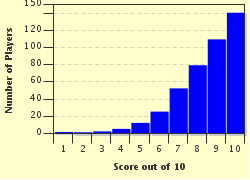Quiz Answer Key and Fun Facts
1. Matter is made up of very small units called what?
2. A very famous scientist realised that matter and energy were really just different views of the same thing, and first worked out the famous equation E=mc2 (energy = mass multiplied by the square of the speed of light) which describes this.
Who was he?
3. Matter is (mainly) found in four states, in other words there are four different ways in which matter can exist in the everyday world.
Which of the following is the fourth one of those states?
Solid, liquid, gas and ...?
4. Help, our matter is missing!
Scientists believe that more than 90% of the matter and energy that exists in the universe cannot be seen even with our best instruments.
What adjective is used to describe this "missing" matter and energy?
5. Scientists think that they have found evidence of one of the most important particles which makes up atoms, the one which helps give everything in the Universe its mass.
The particle is named after the person who first thought of it, so which one of the following is the correct name for the (boson) particle named after him?
6. A highly unusual object is created when a large amount of matter collapses down into a very small space, for instance when a star collapses under its own gravity because it has used up most of its fuel.
Once this object is created, its gravity is so strong that other objects nearby are sucked into it and even light cannot escape from it.
What are these attractive objects usually called?
7. Na is the element sodium, a highly explosive metal. Cl is the element chlorine, a deadly poisonous, yellow-green gas. But when we put them together we get NaCl, which is something we can eat!
What do you think it is?
8. Matter can change from one state to another when you heat or cool it.
At which temperatures does pure water change from solid (ice) to liquid (water), and then from liquid (water) to gas (steam)?
(º is the symbol for degrees, so ºC means degrees Celsius and ºF means degrees Fahrenheit)
9. All elements have a one or two character symbol which is often used to refer to them. With some of these symbols it is fairly obvious which element they mean, for example hydrogen has the symbol H and carbon has C, but with other elements it is far from obvious.
Do you know, or can you guess, which element has the symbol W?
10. Elements can exist in different forms - not in different states, as mentioned above, but in different forms. For instance, coal and diamond and graphite (pencil lead) are all forms of carbon.
A brand new form of carbon (with a very distinctive structure) was discovered in 1985, by scientists from the UK and US, and it was named after an earlier discoverer.
What is that given name for the new form of carbon?
Source: Author
c_g_jung
This quiz was reviewed by FunTrivia editor
NatalieW before going online.
Any errors found in FunTrivia content are routinely corrected through our feedback system.

